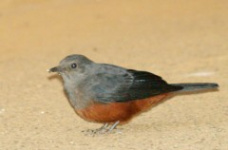
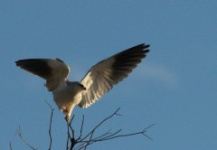
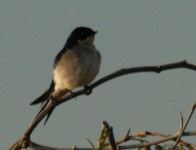
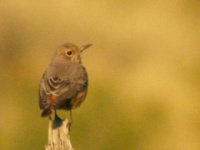
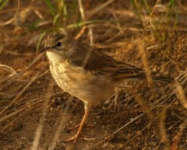
Chapter 47 in Birding Gauteng covers the Pilanesberg National Park & Sun City area. Here are some reports of trips I have taken to this spot.
Trip 1 - May 2010
On Saturday the 29th of May 2010 we left home at 4:30 to ensure that we were at the Pilanesberg National Park when the gates opened at 6:30 and actually got there some 20 minutes early so I decided to chase after the illusive Yellow-throated Sandgrouse. Following the directions from Stuart Groom floating around on the Internet we headed down the dirt road about 2km west of the entrance to Sun City. We had gone for about a kilometer down the road, not in great condition, and after nearly getting stuck on a stump that was hidden in shrubs in the middle of the path decided to call off the search. And this was supposed to be the easier Western side! Time to upgrade to a 4x4 vehicle! Maybe it was a premature decision (who knows what was waiting around the next corned in the bush) but we will have to do the stakeout on another occasion!
We entered the park through the Bakubang Gate and before I even had a chance to pay I was off chasing a female Mocking Cliff-Chat that I had not photographed before. Some Groundscraper Thrush almost grabbed my attention but we paid and started our journey into the park. We immediately turned onto the Kgama loop dirt road and saw Swainson’s and Natal Spurfowl just across the bridge. Along this road we were treated with sighting of Black-shouldered Kite (it took off and flew back to the perch a few times which made for some great pics), a lone Pearl-breasted Swallow, Familiar Chat and Long-billed Pipit.
Once we made it back to the tar road we retraced our steps back towards the main gate to check out the Lengou dam. On the way we saw Yellow-fronted Canary, Kalahari Scrub-Robin and Golden-breasted Bunting.
At the Lengou Dam we saw Egyptian Geese, a lone Pied Kingfisher, a Grey Heron (which was too far back to get a decent pic), an African Darter, a Little Grebe and lots of Hippo in the water and grazing on the bank.
Our goal was to get to Mankwe Dam as early as possible and already it was around 8:15. On the way I heard a little voice in the back seat say: “There’s an Owl, go back!!!” It was Little Birdman, my 5 year-old son, Drew. I reversed (to be honest, every time I reverse birds teleport before I get to the spot, so I nearly kept on driving – hey, I had a dam to get to!!!). Boy, am I happy I reversed. There perched on a branch not more than 3 meters from the side of the road was a stunning little Pearl-spotted Owl. I was scrambling to get a shot off before it flew off – yet it sat and started at us for about 5 minutes – even moving its head from side to side which made us roar with laughter at the attitude it seemed to be giving us. Suddenly it let out a shriek and went flying off with a Dark-capped Bulbul in hot pursuit. I am not sure what that was all about. Not quite sure who was chasing who, but it looked like the Bulbul was chasing the Owl.
During the remaining kilometer or two before arriving at the dam we saw a Monotonous Lark, Plain-backed Pipit, African Fish-Eagle (we watched it swoop down and grab a rodent as well as a whole tuft of dry grass that it calling along with its prey), and a White-throated Robin-Chat.
We arrived at the Mankwe Dam which will forever be remembered as Pied Kingfisher dam. As I sat in the Mankwe bird hide I suddenly realised that a Pied Kingfisher was getting ready to have lunch - he grabbed a fish out of the water right in front of me and the whole lengthy process of eating a fish began. I captured the whole process in these shots.
Pic 1: The Pied Kingfisher scans the water for a fish to have for lunch. He then takes off, hovers above the water befor diving head-first into the water to catch his lunch.[br] Pic 2: He sweeps down into the water, emerges with the characteristic whistle of glee as he has successfully snagged a fresh fish for lunch and returns to his perch positioning it in his mouth for the long preparation process before he can eat it. This is NOT fast food as you will see!!![br] Pic 3: He spends about ten minutes smashing the fish from side to side on the branch he is perched on - first to kill it, but more importantly it seems to tenderise it before swallowing it.[br] Pic 4: He then tosses the tenderised fish into the air to reposition it in his beak.[br] Pic 5: Once he has turned it around he is ready to begin the process of swallow it, head first. A slow and difficult process - not a quick swallow!!![br] Pic 6; It is a large meal and it takes at least 2 to 3 minutes to get the fish down its throat. See how his eyes bulge with the challenge.[br] Pic 7: Finally more of the fish is down his throat than what is left sticking out of his mouth.[br] Pic 8: He dives down into the water a few more times, not fishing now, but rinsing off and taking in water which will help the fish make its way down into his belly.[br] Pic 9: After some shaking to get rid of the water he spends some time warming up in the sunlight and drying off his feather. Surely one of these fish is food enough for the day![br] Pic 10: Now our Pied Kingfisher's shares have gone up and he is joined by a mate.
Before we left the dam, we saw Reed Cormorant (probably a juvenile), White-breasted Cormorant, Great Egret, two nesting Little Grebe, a Green-backed Heron (on the other side of the dam at the outer limit of my camera’s range), House Sparrow (in the hide) and a close up view of a Southern Masked Weaver (perched just outside the hide). The hide was packed with people – and many of them foreigners, seems like the magic of the World Cup is working already!!!
In the car park we were besieged by Natal Spurfowl desperately trying to share our banana muffins, as well as Southern Grey-headed Sparrow, House Sparrow and White-browed Scrub-Robin.
We then did the Hippo Loop where we got to see Golden-breasted Bunting, then a Lifer for me: the Short-toed Rock-Thrush (a male I believe as it seemed to be “snow capped” in the light), another Lifer: Capped Wheatear (unfortunately just a little out of my range for a good pic)and Pied Crow flying around our car.
We then took the Tlou road to explore Makorwane Dam and the other two dams on the Western part of the reserve (Ruighoek and Batlhako). We were not rewarded with much in the three hides (although they gave us a chance to grab a bit to eat for lunch and enjoy the peace and tranquility of the spots). At Makorwane there was a Great Egret perched on a tree in the dam but nothing whatsoever around the hide. At Ruighoek the hippo and terrapins were great to look at – and two Cape Turtle Doves flew overhead. While at the brand new hide at Batlhako which is really stunning, a lone Pied Kingfisher and a Reed Cormorant were all that was breathing. This took place between 11 and 1 so I guess it is understandable for birding around midday!
Driving between these Dams was rather productive, despite the time of day. We saw: Familiar Chat, Cape Glossy Starling (we counted five in one tree and then two drinking in a dam), Marico Flycatcher, Kalahari Scrub-Robin, Lazy Cisticola, Streaky-headed Seedeater, Chestnut-vented Tit-Babbler, Crested Francolin, Sabota Lark, Red-winged Starling, Dark-capped Bulbul, two beautiful Crimson-breasted Shrike, more Golden-breasted Bunting, then for the first time on the day we saw Red-billed Hornbill and Yellow-billed Hornbill (we were wondering where they all were!).
From Batlhako we made our way to the Pilanesberg Education centre where we must have spent close to 45 minutes watching the dozen or so birds come up real close to the wooden deck of the restaurant, including a Brown-hooded Kingfisher (that grabbed an insect and enjoyed the snack), Marico Flycatcher, Helmeted Guineafowl, Crested Francolin, Crimson-breasted Shrike, Fork-tailed Drongo, Dark-capped Bulbul, House Sparrow, Southern Masked Weaver, Speckled Pigeon and Kurrichane Thrush. I won’t even talk about the Wildebeest, Monkey, Warthog and antelope that graced us with their presence.
On the way to the Bakgatla gate (we were heading to take the Dithabaneng route past the last two dams) we saw a Neddicky and then visited the Ratlhogo hide – which is a stunning hide, although we saw nothing on the day apart from Dark-capped Bulbul. Outside I chased a Chestnut-vented Tit-Babbler around trying to get the ultimate shot! Never quite got it!
We then made our way to the Malatse Dam hoping for some last special sightings for the day. The spot is beautiful and the hide well positioned but there was not much around apart from a Black Crake and some Blacksmith Lapwing (which amazingly we had not seen all day!).
The next exciting moment came when my wife shouted from the back seat (where Drew had been sitting before – he was now riding up front with me) – “Go back, go back”. After the last Go Back episode, I was not about to keep driving. As I got back to the spot we saw a squirrel on a low tree near the road and a smallish raptor eyeing it out. I pulled off a hand held shot or two only to realize that my camera was set for a sky shot I had just taken (talk about Photography 101 - basic rules of preparedness). And horror of horrors, the raptor flew off behind out car. I was devastated – I immediately thought it was a Shikra (would this forever be the “Lifer that got away”). In desperation I reversed some more and saw it in a tree on my side of the road – having adjusted the ISO and Shutter Speed I thought I would have gotten the shot, only to check the screen and discover that it was still way too dark! Nooooooo! And it flew away! Rats!!!! This is the pic I got (and a pic of the Squirrel that Little Birdman snapped):
Amazingly it circled around, probably desperate to have the squirrel for afternoon tea and we spotted it again just three meters from the road side. Finally we got some shots that were more than just record shots. We drove on towards the Manyane campsite complex marvelling at what we had just seen, still debating whether it was a Shikra or a Little Sparrowhawk. Only later once we got the pics downloaded did we conclude that it was in fact a Little Sparrowhawk – the yellow eyes and the white spots on the barred tail confirming it for us. Sadly, and fortunately for the squirrel, I think our sudden arrival may have cost it a snack!
At the Manyane Complex we visited the bird aviary – a highly recommended stop in the park. It was kinda sad given the amount of birds that congregated on the wire mesh above the aviary, namely Red-winged Starlings and Arrow-marked Babblers – trying to communicate with their friends inside the cage. But it did allow us to get up close to species like Black-headed Oriole, Red-winged Starling, Red-billed Firefinch, Dusky Indigobird, African Grey Hornbill and Yellow-billed Hornbill, Red-billed Quelea, Blue Waxbill, Common Waxbill and Crested Barbet. Fortunately, there were no Lifers inside the cage so I was not tempted to photoshop any pics and pretend we took them in the wild in the park. I do upload pics taken of birds in the wild to my site, but mark them as birds in captivity. Gotta keep it real!
We left the park, promptly took a left turn to make our way to the R510, and thanks to another instance of a total absence of signage had to do an about turn some 5kms down the road. How are our birding guests coming to Soccer 2010 going to find their way around our country??? I considered heading off to the western route where the Sandgrouse is supposed to drink in the afternoon, but thought that my family’s patience might be running out – so we headed back to Johannesburg (we saw some Black-shouldered Kite, Magpie Shrike, and unfortunately my wife saw a dead Spotted Eagle Owl on the R24 about 10kms from Rustenburg towards Joburg). It is so sad to see a bird that has been knocked over by a car!
Be warned, Mr and Mrs Sandgrouse, one day I will be breaking your quiet drink with the sound of my camera buffer filling up with Lifer shots!!!
All in all we saw 78 different bird species on the day and I recorded 6 Lifers. Some of the other birds that we saw during the day were: Lourie, Cape Turtle Dove, Long-tailed Widowbird, Cape Longclaw, African Stonechat, Red-billed Oxpecker, Lilac-breasted Roller (only one the whole day – I guess they have flown north for winter), and a Tchagra (that move to quickly to identify). A great day of birding!!!
Finally, here are some scenery pics that were taken on my wife's Canon Powershot camera:
Trip 2 - November 2010
On Saturday the 13th of November 2010 I took my whole family for an outing to Pilanesberg - it was to be a family focussed day so I knew that it would have to be "birding-lite"!
We arrived at the Bakubang gate entrance and managed to scrape together enough cash for the entrance fee as their electronic system is down due to a recent fire (a kind stranger loaned me R10 as I was short and was about to go and look for an ATM somewhere). Extensive renovation is taking place to improve the gate. It looks promising!
On the way to the Lengau Dam (heading towards Mankwe Dam) we saw Greater Striped Swallow, Red-breasted Swallow, Cape Glossy Starling, Cape Turtle Dove, Brown-hooded Kingfisher, Swainson's Spurfowl, Tawny-flanked Prinia and Lesser Striped Swallow.
After stopping to watch a herd of Elephant bathing in a stream we arrived at the dam and saw Little Grebe, Yellow-billed Duck, African Darter, Egyptian Goose, Blacksmith Lapwing, Black-throated Canary, Southern Masked-Weaver, African Pied Wagtail, Three-banded Plover, Sacred Ibis and a Pipit that I am yet to identify.
On the road to Mankwe Dam we saw Diderick Cuckoo, White-winged Widowbird, Kalahari Scrub-Robin, Southern Red Bishop, Grey Go-away-bird, Black-chested Prinia, Familiar Chat, Long-tailed Widowbird, Amethyst Sunbird, White-browed Scrub-Robin, Red-faced Mousebird, Golden-breasted Bunting, White-browed Sparrow-Weaver, Cape Glossy Starling, Common Ostrich, Natal Francolin, Helmeted Guineafowl and Red-backed Shrike.
At Mankwe Dam we saw Green-backed Heron, White-faced Duck, Pied Kingfisher, Levaillant's Cisticola (if my id is correct), European Bee-eater, House Sparrow, Southern Grey-headed Sparrow, Common Myna, Little Grebe, Reed Cormorant, Little Egret, Red-winged Starling, Blacksmith Lapwing, Pied Kingfisher, Sacred Ibis, Cape Wagtail, Little Swift, Grey Heron, Common Waxbill and Egyptian Goose. There is a pic of a Dragonfly because my wife says that people go from animals to birds to insects (smaller and smaller as our lenses get bigger and bigger!!!).
Our next stop was at the Pilanesberg Educational Center where we saw Yellow-fronted Canary, Marico Flycatcher, Namaqua Dove, Great Egret, Crimson-breasted Shrike, Pied Crow, Helmeted Guineafowl, Southern Masked-Weaver, House Sparrow, Grey Go-away-bird, Cape Glossy Starling, Red-winged Starling and Dark-capped Bulbul. There is one mystery bird that I still need to identify in this group.
We took a brief drive along the road past Makorwane Dam which did not yield many bird species on my last trip - this time we saw Tawny-flanked Prinia, Little Swift, Greater Striped Swallow, Egyptian Goose, Blue Waxbill, Great Egret, Little Egret and Sacred Ibis.
In the area near the Tlou Dam I saw two Buffy Pipit on the roadside and was thrilled with the pics that I got.
By now it 11:30 and getting stinking hot and it looked like my family were done for the day - so we headed to the Bakgatla Gate (seeing Fork-tailed Drongo and Magpie Shrike on the way) before leaving the park and heading home. We stopped at two dams on the way home - one on the R510 to Rustenburg and the other on the R24 to Krugersdorp. I have posted trip reports for each spot.
The mammals we saw along the way include Elephant (the little elephant never did make it up that bank!), Zebra, White Rhino and Giraffe - as well as a Hippo that we were warned was troubling cars - and it walked right next to us!
In total we saw 61 bird species and despite not getting a lifer it was a great family outing! My son's girl friend had never seen Elephant, Rhino or Giraffe in the wild so it was awesome watching her excitement at seeing them for the first time!
Trip 3 - May 2011
In March 2011 I took my family for another outing to Pilanesberg. It was a great time out but did not prove to be a big day for birds. The highlight was a huge flock of Marabou Stork drinking at a dam as well as watching a Cape Sparrow feeding an infant and a sighting of Lesser Moorhen. Here are some pics that I took:
Trip 4 - August 2012
On Saturday the 18th August 2012 I offered to take two American friends on a day safari to Pilanesberg. Our focus was on mammals - hoping to see the big 5 - but by the time we left the park around 6pm we had seen over 100 bird species!
A real highlight of the day happened as we made our way to the bird hide at Mankwe Dam. I spotted an unusually shaped water bird close to the shoreline of Mankwe Dam and instinctively slammed on brakes shouting "Finfoot!!!" This bird made it's way up and down the shoreline for about 300 meters catching fish. We eventually had to move on - this is the first time I have ever walked away from a Finfoot sighting. These are the best shot I was able to manage - I was so tempted to take my chance with the hippos, crocs and maybe even lions - and walk down to the shoreline to get a better shot. Not likely!
The next highlight happened on the way to the bird hide - I spotted a movement and a Little Bittern moved into view and proceeded to preen itself right in front of me for 10 minutes or more. An amazing sighting given that I could almost reach out and touch it.
There was also a rather close encounter with a Crimson-breasted Shrike right next to the road:
Here are some shots of waterbirds:
Here are some other bird shots that I took during the day at Pilanesberg:
Here is a list of all the birds we saw: Spurfowl Swainson`s, Francolin Crested, Pigeon Speckled, Go-away-bird Grey, Shrike Magpie, Roller Lilac-breasted, Tchagra Black-crowned, Mousebird Red-faced, Robin White-browed Scrub, Bunting Golden-breasted, Lark Rufous-naped, Bulbul Dark-capped, Swallow Lesser Striped, Hornbill African Grey, Thrush Groundscraper, Spurfowl Natal, Fiscal Common, Cisticola Rattling, Quail Common, Puffback Black-backed, Flycatcher Marico, Barbet Crested, Pipit African, Heron Grey, Grebe Little, Spoonbill African, Cormorant Reed, Jacana African, Lapwing Blacksmith, Duck Yellow-billed, Kingfisher Pied, Wheatear Capped, Egret Great, Duck White-faced, Coucal Burchell`s, Eagle African Fish. Hamerkop, Darter African, Cormorant White-breasted, Martin Brown-throated, Cormorant Reed, Stonechat African, Oxpecker Red-billed, Swift African Palm, Goose Spur-winged, Finfoot African, Heron Goliath, Babbler Arrow-marked, Shrike Crimson-breasted, Boubou Southern, Warbler African Reed, Plover Three-banded, Robin-Chat White-throated, Guineafowl Helmeted, Lapwing African Wattled, Snipe African, Eagle Black-chested Snake, Egret Little, Cisticola Levaillant`s, Sparrow Southern Grey-headed, Lark Sabota, Goose Egyptian, Weaver Southern Masked, Jacana African, Canary Yellow-fronted, Seedeater Streaky-headed, Boubou Southern, Tit-Babbler Chestnut-vented, Eagle Verreaux`s, Tchagra Brown-crowned, Chat Familiar, Swallow White-throated, Pipit African, Pipit Long-billed, Robin Kalahari Scrub, Robin-Chat White-throated, Wagtail Cape, Sparrow Cape, Thrush Kurrichane, Dove Red-eyed, Ostrich Common, Lapwing Crowned, Crow Pied, Drongo Fork-tailed, Prinia Tawny-flanked, Dove Cape Turtle, Firefinch African, Firefinch Red-billed, Pytilia Green-winged, Ibis African Sacred, Swift African Palm, Heron Goliath, Bishop Southern Red, Crake Black, Snipe African, Kingfisher Malachite, Warbler Lesser Swamp, Darter African, Bittern Little, Crake Black, Hoopoe African, Shrike Crimson-breaste, Waxbill Blue, Flycatcher Marico, Kite Black-winged, Woodpecker Cardinal. Weaver Scaly-feathered, Martin Brown-throated, Swallow White-throated, Swift White-rumped, Duck African Black, Ibis Hadeda, Kingfisher Pied, EgretLittle, Chat Mocking Cliff, Swallow Greater Striped.
Here are some mammal highlights from the day:
Elephant - We spotted this herd of elephant in the distance and made our way to a spot across a stream where we anticipated they would walk - it proved to be a wise decision!!! They passed peacefully within 15 meters of our car about 30 minutes later.
While I was birding at the Educational Center (the picnic area that has been closed for a while) I looked up and not more than 30 meters from me was this old bull elephant. I had a tactical retreat and got some great shots as it drank at the waterhole. At one point when the Elephant suddenly started walking towards us again, the group of tourists standing on the concrete verandah considered running away as he made his way towards us. I urged them to stand still and he took a long look at us before moving off peacefully. An incredible experience!!!
Of course the buck were out in full force:
We only had one cat sighting on the day. We spent a whole watching 2 lion in the distance and possibly a third. Sadly the gate was closing in 15 minutes and we had to leave the spot!
Here are some critter sightings (Can you spot this water monitor's head sticking out of the gap on the top left hand side of the photo?):